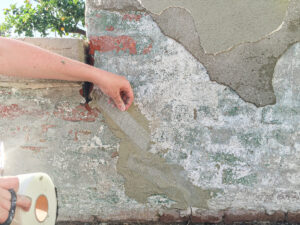Stucco Philadelphia adds a nice texture to a home, but there may be a time when you want to remove it. If you notice dark staining around windows or doors, mildew or rot, or discover severely deteriorated brick beneath your stucco, this is an indicator that it’s time to remove it.
Stucco texture adds durability and beauty to exterior walls, but sometimes, it needs to be updated or repaired. Removing stucco can give a home a new look or make room for insulation and other energy-saving improvements. A reputable team of professionals can complete the project quickly and efficiently.

Before beginning the stucco removal process, it’s important to prepare the work area. Use tarps or drop cloths to cover the floor and protect furnishings, fixtures, and landscaping from dust or debris. It’s also important to remove obstacles that might get in the way or pose a risk of injury.
Safety goggles, a dust mask, and work gloves are essential safety equipment for this renovation project. It’s also a good idea to set up signage or warning tape around the work area to alert others of the ongoing demolition and reduce the risk of accidental intrusion or disturbances.
There are several different types of tools used in the stucco removal process. Some of the most common include a scraper, putty knife, long-handled scraper, and a power washer. A grinder with a diamond blade is also useful for cutting through sections of the stucco to expose the underlying lath.
When removing stucco, it’s crucial to avoid damaging the underlying brick or masonry. If the masonry is deteriorated and needs repair, it’s best to call in a professional mason to ensure the integrity of the wall is maintained. A mason can also inspect the underlying structure and address any issues causing damage or leading to future problems.
In addition to evaluating the overall condition of the brick, masons can also check for signs that the stucco is starting to crack. While some cracking is normal, large or wide cracks can indicate a problem with the foundation or structural integrity of the building. Cracks that appear to be getting larger or elongating in size should be addressed immediately.
If the cracked stucco is due to a structural issue, the mason will likely recommend repairing the affected areas rather than removing the entire wall. In some cases, it may be necessary to install a vapor barrier on the wall’s interior to prevent moisture buildup that can lead to mold and mildew.
Stucco is an attractive and durable exterior wall material that can be used to update a home or commercial building. However, stucco that is not applied properly can result in serious damage and deterioration. Taking the time to prepare and execute the stucco removal process properly can help ensure a successful project and a beautiful new look for your walls.
To begin the stucco removal process, workers must first gather the necessary materials. The most important are safety equipment, including a dust mask and work gloves to protect the wearer from harmful substances. In addition, a power washer will be useful to clean the surface of the walls before starting the stripping process. Other items include a ladder, plastic sheeting, and buckets for collecting waste.
Next, workers will need to lay out tarps and scaffolding where necessary. They will also need to assess the condition of the stucco texture and determine if there are any other issues to address, such as mold or moisture problems. The condition of the stucco will influence how easy it is to remove, and addressing any problems now will make the removal process go more smoothly in the future.
Once the tarps are in place, contractors will use a hammer or a crowbar to punch a hole through the layer of stucco. This is necessary to expose any underlying brick or other components of the wall and to determine if there is mesh holding the stucco to the brick. If there is, it will be necessary to remove this as well to prevent damage to the brick during the stucco removal process.
If there is no mesh, it will be possible to proceed with the stucco removal process. However, if there is a large amount of mortar that has crumbled from the brick or other issues that need to be addressed, it might make more sense to hire a professional stucco company to handle the removal. The professionals can safely and quickly complete this labor-intensive task to give your walls a beautiful finish lasting years.
Before starting to remove stucco from the walls of your home, be sure to take the necessary safety precautions. First, turn off any electrical outlets and switches on the wall you will work on. You should also apply masking tape around the area to protect adjacent surfaces and prevent accidental damage. Finally, be sure to ventilate the space. Opening windows and using fans will help to reduce the buildup of dust and debris.
When you are ready to begin, choose an isolated wall section to test your method. A good spot is a corner or an area behind a window or door, as these areas tend to deteriorate faster than the rest of the wall. Carefully inspect the surface of the stucco, looking for cracks or holes. Make a note of any problems that you notice. Washing a stucco surface that is damaged can allow water to enter the wall, leading to mold, mildew, and other unwanted fungi.
To prevent future fungus problems:
- Rinse the stucco wall periodically with a garden hose sprayer.
- Use a low-pressure setting, as too much force may cause damage. If you find stains on the wall, mix a solution of one part non-chlorine bleach with three parts water and apply directly to the affected area.
- Let the solution penetrate the stains for five to 10 minutes, then rinse thoroughly.
Loose stucco can be identified by tapping the wall gently with a hammer. It will sound spongey, while intact sections will sound solid. Once you have found loose areas, you can pull them off by hand or with a pry bar. Open sections should be removed before patching.
If you choose to use a power sander, you should wear a dust mask and goggles to protect yourself from the fine particles generated by this process. Work in small sections and move the sander slowly, using smooth, even motions. If you prefer, you can use a hand sander instead of a power sander.
If you are still determining whether or not your stucco can be salvaged, contact a professional for advice. They will be able to give you an accurate assessment of the condition of the wall and recommend the appropriate removal methods.
Before you can begin removing stucco, it is important to test the condition of the wall and the bonding between the cladding and wood framing. To do this, tap the surface of the stucco with a hammer or your knuckles to see if it sounds hollow or lacks a solid thud. If the stucco feels loose, it needs to be better bonded to the wood framing underneath and could be more difficult to remove than you might think. Similarly, try scraping the stucco to see if it comes off easily. If it is easily removed, it may not need to be fully remediated, and only a partial removal is required.
In addition to these simple tests, it is also a good idea to have your home or commercial property inspected by a qualified professional. This is not only to identify any existing damage, but it can help prevent the spread of moisture into other parts of the building or structure and potentially lead to mold. Moisture meters can be used to detect areas of moisture penetration, and a variety of different testing methods may be employed, including:
The most significant advantage of an inspection is that damaged stucco can be identified before it becomes too severe to repair. This can save thousands in repairs and remediation costs, as what would have otherwise been extensive interior damage can be stopped from destroying the structure.
Stucco removal is a time-consuming, labor-intensive project that requires careful attention to detail. It is also important to prioritize safety and take frequent breaks, especially when working alone. It is recommended that you use a mask for respiratory protection and protective eyewear to avoid exposure to stucco dust and other hazardous materials.
Once the stucco has been removed, it is important to thoroughly clean the wall surface to remove any dust or remaining traces of the previous coating. The surface should then be sanded to create a smooth, even surface. A new weather barrier and flashing should protect the wood framing from moisture penetration. In some cases, a waterproof membrane may be needed as well.


